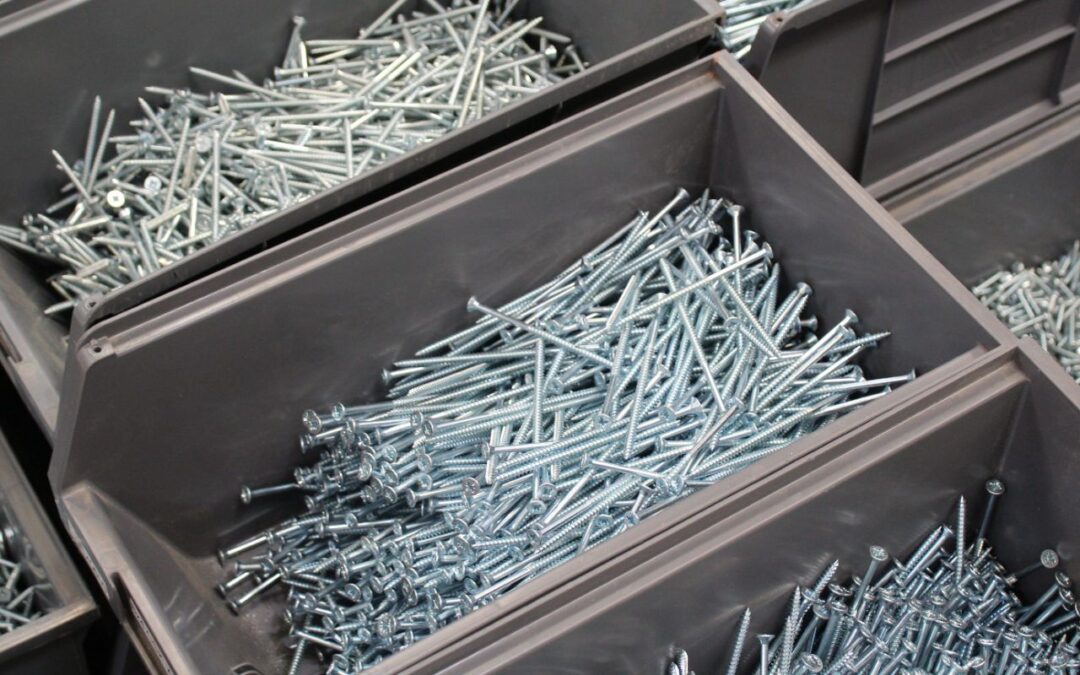Finding The Correct Screw
Just as using the right tool ensures safe and efficient work, selecting the appropriate screw is vital for securely fastening materials. Screws are designed to hold materials together effectively, making it essential to choose the right one for each specific task.
Selecting the Right Screws
When selecting the correct screw for your job, it is essential in understanding the different types of screws available. Below, are the most common screws and how they are used.
Types of Screws
Wood Screws –
Wood screws are sharp-pointed screws for non-structural, wood-to-wood fastening. Wood screws have coarse threads and an unthreaded shank near the head, which allows the screw to pull the wood pieces tightly together.
Drywall Screws
Drywall screws are fully threaded screws for interior projects, such as securing drywall to studs. Coarse-threaded screws are for hanging drywall on wood studs, while fine-threaded screws work with metal studs. Drywall screws don’t have the strength to support cement board and tile.
Deck Screws
Deck screws are designed for decks, fencing and other outdoor construction projects. Deck screws are either made of wood or a composite metal. Wood deck screws have a coarse-threaded portion and an unthreaded shank, like standard wood screws. Composite deck screws have finer threads and smaller heads. Some have a second set of threads to prevent the composite material from mounding at the screw head.
Structural Wood Screws
Structural wood screws have a design, like wood screws, with coarse threads and an unthreaded shaft. However, they’re much stronger than basic wood screws. Depending on building codes, they can function like lag screws or bolts.
Machine Screws
Machine screws are fully threaded screws that secure metal components together. Socket cap screws are machine screws that have a raised, cylindrical, hex-socket head. Socket set screws are headless with an internal hex socket.
Sheet Metal Screws
Sheet metal screws are fully threaded screws designed to fasten sheet metal or sheet metal and softer materials. Some are designed for use with pre-drilled holes, and they’re also available with self-drilling points.
Other Screw Types
A person using a gold trim screw to secure a post cap to a deck post. In addition to standard screw types, you may see some other types for specific applications:
Self-tapping screws are useful if you’ll be removing and reinstalling the fasteners regularly. A self-tapping screw drills a hole and cuts threads as you drive it. While this type of screw drills a hole for itself, a pilot hole is a good idea if splitting is a concern, such as on the end of the board.
Cabinet-mounting screws secure cabinets to studs in the wall.
Dowel screws are headless screws with points and threads on both ends for attaching wood components together without visible fasteners.
Trim screws have a small, countersinking head, making it easier to conceal the fasteners.
Wall plate screws are machine screws that fasten covers for light switches, outlets, etc., over electrical boxes.
Security screws require a specialty driver or bit to remove.
Materials and Finishes
The material and finish of a screw are crucial in determining its suitability for specific tasks and environments. Certain materials enable screws to support heavier loads, while others offer protection against rust and corrosion. For materials prone to moisture-induced corrosion, various finishes are available to enhance their resistance to deterioration.
Steel is the most common material for screws, but it corrodes when it contacts moisture. Steel screws need a corrosion-resistant coating or plating to protect them from moisture. Some common coatings and finishes are zinc plating, hot-dipped galvanized and black phosphate.
There are several other finishes — including powder-coated paint, electrocoated paint (e-coat), polymer, ceramic and some proprietary coatings — that make steel screws corrosion-resistant. Decorative finishes, such as brass, chrome and nickel plating, add some corrosion protection but are best for indoor applications. Bright steel screws have no corrosion-resistant coating and are for interior use where they won’t contact moisture.
Additional screw materials include stainless steel, brass, bronze and aluminium.
Tip
Many fasteners are designed for specific purposes and aren’t suitable for other applications. For example, the strength and durability of stainless-steel screws make them a good choice for outdoor projects like raised garden beds and decks. Always follow code specifications and manufacturer’s instructions.
Thread Types
Coarse-threaded screws have more space between the threads. They’re usually designed for softer materials, like wood or drywall, though sheet metal screws also have coarse threads. You can install and remove coarse-threaded screws relatively quickly.
Fine-threaded screws are typically intended for pre-tapped holes in metal or for use with nuts. Smaller gaps between the threads give them a tight hold, but they take longer to install and remove. You may see listings of thread count or thread pitch. A higher thread count, measured in threads per inch (TPI), indicates finer threads on a standard screw. A smaller thread pitch, or gap between threads in millimetres, indicates a finer threaded metric screw.
Designs, such as twin threads, dual threading and serrated threads, offer minimized splitting, improved fastening and easier driving.
Head Types
A drill driving a screw into wood.
Some screw heads are designed to fit countersunk holes — shallow depressions in the work piece. Depending on the screw, the head may rest flush with the surface as with flat-head and bugle-head screws, or a portion of the head may remain above the surface for decorative purposes as with oval-head screws. Some screws are self-countersinking. They cut the countersunk hole as you drive them.
Non countersunk screws, such as those with round heads or pan heads, rest on top of the surface.
Screws with truss heads, washer heads and wafer heads provide a larger contact area under the screw head than other screw types.
Trim-head screws have small heads, making them easier to conceal than other head types.
Screw Sizes
The diameter shown for a screw is usually the outside diameter of the threads (also known as the major diameter). For screws measured in inches, diameters of 1/4 inch and smaller (for machine and sheet metal screws) or 5/16 inch and smaller (for wood screws) are expressed with a # and a whole number (ex., a screw with a major diameter of 3/16 inch is a #10 screw). Smaller numbers indicate smaller diameters.
Length indicates the distance between point and the work piece surface once the screw is installed. For example, on flat-head, countersunk screws, this runs from the point to the top of the screw head. On oval-head, countersunk screws, length runs from the point to where the screw head meets the surface of the work piece. On non countersunk screws, it runs from the point to the bottom of the head.
A screw’s measurements are usually indicated as diameter x length, so a countersunk wood screw with a 5/32-inch diameter and a 1-1/2-inch length would be labelled as a #8 x 1-1/2-inch countersunk head wood screw.

